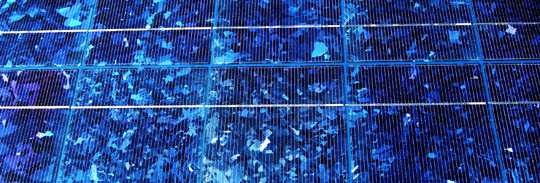



Photovoltaic cells produce electricity directly from sunlight. Photovoltaic cells are also called PV cells or solar cells. Many PV cells are used in remote locations not connected to the electric grid. Photovoltaic cells comprise the main component in solar panels and are also used to power watches, calculators, solar lights, and lighted road signs.
When sunlight strikes a solar cell, electrons are knocked loose. They move toward the treated front surface. An electron imbalance is created between the front and the back. When a connector, like a wire, joins the two surfaces a current of electricity occurs between the negative and positive sides. These individual solar cells can be arranged together in a PV module and modules can be grouped together in an array. Some arrays are set on special tracking devices to follow sunlight all day long.
Photovoltaic cells, like batteries, generate direct current (DC), which is generally used for small loads (electronic equipment). When DC from photovoltaic cells is used for commercial applications or sold to electric utilities using the electric grid, it must be converted to alternating current (AC) using grid inverters, solid-state devices that convert DC power to AC.
Consider where your home is located and how much electricity you currently use. Proper solar panel installation requires a southern orientation that receives direct sunlight from 9am to 3pm daily. The average American household uses 600 Kilowatt-hours of electricity per month. An energy efficient home may use only half that much. In a sunny climate, a 2-kilowatt PV system can produce 300 kilowatt-hours of electricity per month. (To produce 2 kilowatts of power you need about 240 square feet of solar panels.) So, your first move in developing a solar system is to reduce electricity consumption. It is always more cost-effective to invest in energy efficiency than to install a larger PV system.
When solar manufacturers and installers talk about costs, they usually speak in terms of dollars per installed watt. Residential PV systems are normally $8 - 11 per watt. Using this approximate calculation of installed costs results in a total installed cost range from $5,500 to $22,500 for 0.5kW - 3kW residential PV systems. (kW = kilowatt or 1000 watts.) Consider thinking about photovoltaic system power as an investment in energy security and environmental responsibility, as well as, being a financial decision. By owning a PV array and producing clean electricity, you become part of the clean energy movement and gain immunity from price fluctuations.
1.) Photovoltaic cells are highly reliable and easy to maintain. PV cells have no moving parts, so visual checks and servicing are enough to keep systems up and running. Solar panels are built to withstand hail impact, high wind, and freeze-thaw cycles. PV systems can produce power in all types of weather. On partly cloudy days, they produce as much as 80% of their potential energy. Even on extremely cloudy days, they can still produce about 25% of their maximum output.
2.) Photovoltaic cells have virtually no environmental impact. PV cells burn no fuel and have no moving parts. They are clean and silent, producing no atmospheric emissions or greenhouse gases that are harmful to the earth.
3.) Photovoltaic cells strengthen our economy and reduce the trade deficit. Using PV cells protects us from fuel price volatility and political instability. It lets us generate our own energy within American borders. We are investing in “home-grown” energy, which creates domestic jobs. As we keep increasing our PV exports, the trade deficit moves toward a trade surplus.
4.) Photovoltaic cells are modular and flexible in terms of size and applications. PV cells can be built to any size in response to the energy needs at hand. They can be enlarged or moved easily. In urban applications, PV can eliminate the need for costly trenches in streets.
5.) Serves both form and function in a building. State-of-the-art PV modules are available in a variety of colors and styles, allowing designers to use them as aesthetic elements built right into roofs, skylights, awnings, entryways, and facades. Modules can be built to transmit natural light. Mixed with nontransmissive modules, these arrangements create an enjoyable environment inside the building, simultaneously facilitating ventilation and heating.
Sources: U.S. Department of Energy, Southface Energy Institute
Tags: photovoltaic solar cells, what are photovoltaic cells, thin film photovoltaic cells, cheapest, highest efficiency
877-331-1235 | © Copyright DASolar.com.